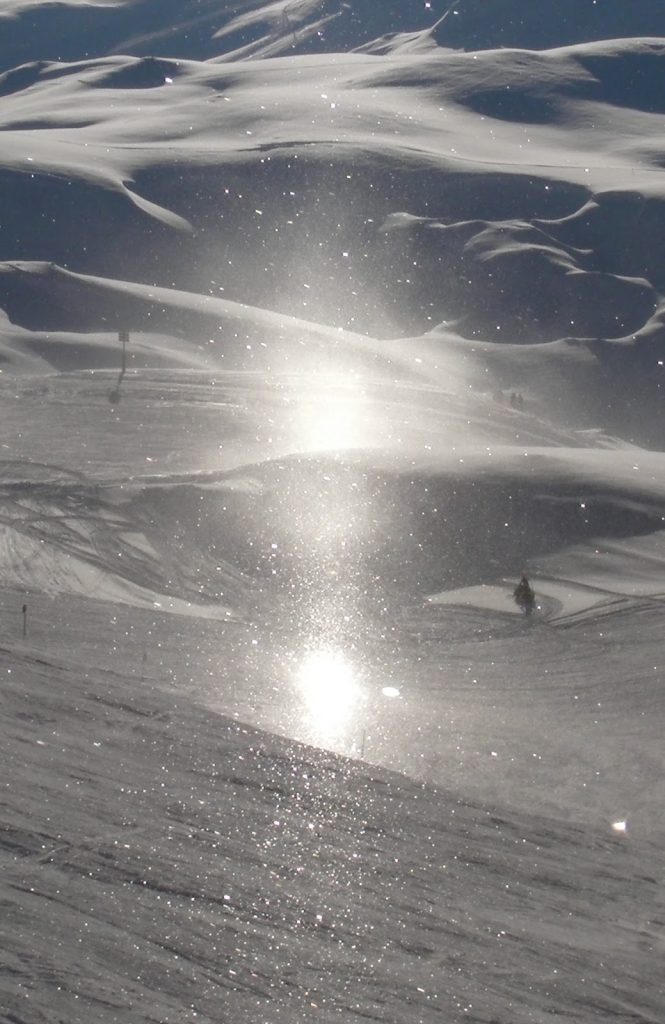Exercise two: Side-slip, Controlled by angulation.
On a steep slope the skis are placed across the hill and the upper body faces downhill. The pelvis is aligned with the shoulders and the bottom faces uphill. This permits the skis to be held strongly on edge due to the resultant angles (angulation) at the hip joints. By standing up slightly the centre of mass moves slightly downhill and the edges are released slightly so the skier slips down the mountain. To stop, the anglulation is increased by pushing the bottom further up the hill by bending down again. This also simulates the placement of the body towards the end of a short turn and how to control the centre of mass – that is to keep it to the inside of the turn appropriately and to bring it up and out appropriately when the turn has to be finished and a new one started. Both skiers struggled with this exercise due to a tendency to prefer to point the bottom downhill – thus locking up the hip joint and “resisting” – that is getting all the muscles to fight against each other rather than be used selectively and appropriately. This is a normal issue linked to physical awareness levels – which improves with practise.
Exercise three: Practical application off-piste.
Audrey did very well until we got onto the steep slopes in the following video. This brought out clearly all the faults described at the start – and probably ruined Huw’s day. Look at how far back you are leaning Huw!!!!
Exercise four: Short Swings.
I decided to push harder in the same direction as the exercises already done – by doing short swings – which are an extreme form of short turns that might be used in a couloir or tricky situation where jumping is necessary. Regardless of practical use it makes a great exercise. We began by jumping with the skis off and then making turns (legs only from the hip joints) with the skis off by jumping. This helped to familiarise everyone with the sort of leg positions reguired and the sort of ballistic movements required. All rotation had to take place only in the hip joints. It was shown that it is easier to avoid hip rotation and spinal rotation if the feet are kept apart at an equal height on the hill and rotated in the air like a pair of windscreen wipers. When the feet are side by side and the top one becomes the bottom one when jumping – then it is much harder to keep the rotation confined to the hip joints – but both ways are valid if executed correctly. Feet “close together” is best used in sort turns that don’t have to be closed off too much such as when bump skiing or on a shallow off – piste gradient where the skis can run almost straight downhill and the skier is slowed down by the deep snow.
We worked on bouncing with a rhythm and on short swings with only slight truning of the skis in mid air. I demonstrated “edge to edge” short swings. Both skiers had trouble coordinating the two legs to jump simultaneously – particularly Audrey. Huw had trouble getting a rhythm and bounce. Both had difficulty avoiding rotation and didn’t manage to use the poles to help the body jump up to release the edges. Huw had a tendency to retract the heels when jumping instead of extending the legs fully and getting the centre of mass higher. Still, it’s a very tough exercise to learn.
Exercise five: Rhythm (off-piste)
We took the bouncing into the off-piste in soft snow to load the skis up like trampolines and make the bounce rhythm more obvious. This worked to some extent but when used on shawllow turns Audrey did not coordinate the legs to “bounce” simultneously and so became unstable. Huw couldn’t coordinate the bounce with the turn at this stage.
Exercise six: Skating/Dynamics with Upper/Lower body separation (Huw Only).
Finishing the day with Huw only, we stayed on the piste and went back to Huw’s favourite – dynamics! Using skating I demonstrated that the body should remain facing downhill and that the ski changed the leg direction suring the skate which was an arc – not a straight line. This was to show how the upper/lower body separation at the hip joints is really a universal skill that applies to all areas of skiiing. Huw managed this with more success. He could also see how the deliberate angulation combined with downsink into the turn would really load up the ski in a short carved turn – something that does not happen if the body follows the ski around the turn and there is no angulation and no vertical leg action.

